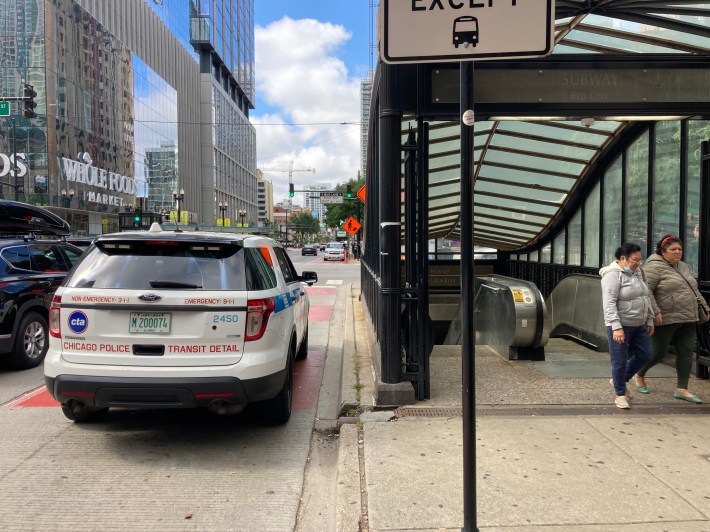Streetsblog Chicago has invited all Chicago mayoral and alder candidates to send us their positions on transportation and traffic safety issues for possible coverage. Previously we’ve looked at state rep Kam Buckner’s transportation plan and Chicago Police Department Freedom of Information Act officer Robert Earnshaw's transportation platform. We've also covered businessperson Willie Wilson's bus ride downtown to highlight CTA safety issues, and incumbent mayor Lori Lightfoot's 2023-24 infrastructure plan.
On Monday, community activist and mayoral hopeful Ja’Mal Green (pronounced JAY-Mahl) announced his plan to improve safety for CTA riders. At 27, Green is one of the youngest people to run for Chicago mayor. According to his campaign website, his mayoral platform focuses on four areas: public safety, modernizing city government, transportation, and climate justice.
In an interview with Crain’s Chicago Business, Green outlined a $200 million annual plan to increase safety on the transit system. A priority of this proposal is to create a “peacekeepers protective agency” within the CTA. The peacekeepers would connect unhoused riders and/or passengers with mental illness to supportive services. Further support would be provided by trained social workers.
Green told Crain's, “We’ve got to get these people off the trains and into social support services.” He said he sees the uptick in violence on the system and the consistent presence of unhoused individuals on CTA trains and buses as a "public health emergency."
Green's proposal comes after the CTA approved $71 million in contracts for unarmed security guards, and another $31 million contract for attack dog patrols. And some local transit union members have proposed creating an in-house CTA police department. Despite the increased spending on security measures, the number of violent crimes on the system has continued to increase.

In addition to calls for peacekeepers and social workers, Green wants to see an increase in cleaning on CTA trains and buses. He envisions formerly incarcerated individuals and veterans filling new cleaning positions. Green would also like to offer incentives to work for this program in the form of free City Colleges of Chicago tuition. Lastly, Green would like to follow the Boston’s lead and pilot reduced or free transit fares along certain routes.
Interestingly, Green would like Governor JB Pritzker to declare a state of emergency regarding the uptick in violence on the CTA. Green says the declaration could free up funds to implement his plan. In the Crain's interview, he noted that Pritzker has previously declared a state of emergency in response to COVID-19 and migrants being bused to Illinois from border states. He argued that if Illinois has money for migrants, there should be funds for the CTA as well.
While there certainly is a need to provide services to unhoused individuals who currently ride the CTA, I find it hard to believe that many riders would be on board with Green’s plan to hire many more outreach workers while there's a major bus and train operator shortage, which is contributing to unreliable service and long waits between runs. That is forcing some Chicagoans to budget a lot more time for their transit commutes in case of a delay. $200 million could have a sizable impact on service if it went toward increasing salaries for CTA bus and 'L' drivers.
Green’s website states, "Having a safe, reliable and affordable transit system is a luxury that most cities cannot attest to. The functionality of Chicago’s transit system works, but with modern updates and more safety protocols, the system would be able to operate on a heightened level." I was turned off by him labeling transit as a "luxury". For many Chicagoans, about 25 percent of whom do not own a motor vehicle, the CTA is their lifeline; it’s how they get to work, school, medical appointments, entertainment, etc. Secondly, Green offers zero details on what sort of modern upgrades he would like to see.
The website goes on to say that residents should feel safe on transit and suggests that many residents are avoiding the CTA due to safety concerns. While it’s certainly true some people have abandoned the system recently due to safety concerns, particularly at night, a bigger reason why CTA ridership hasn't fully recovered from the pandemic is unreliable service.
Even before COVID, CTA travel times were often uncompetitive with driving. Until we make buses and trains at least as time-efficient for getting across town as cars, there will always be large numbers of Chicagoans who will choose to drive. By making service more frequent, faster, and more reliable, we can make the CTA safer through increasing ridership, leading to more "eyes in the system" to deter crime. That in turn will build political support for further investment, creating a virtuous cycle. I’m just not sure Green’s plan is enough to remedy the current challenges the CTA faces.
Correction 10/19/22, 4:30 PM: This piece previously misattributed a quote from Green's interview with Crain's. Apologies for the mix-up. - John Greenfield, co-editor






